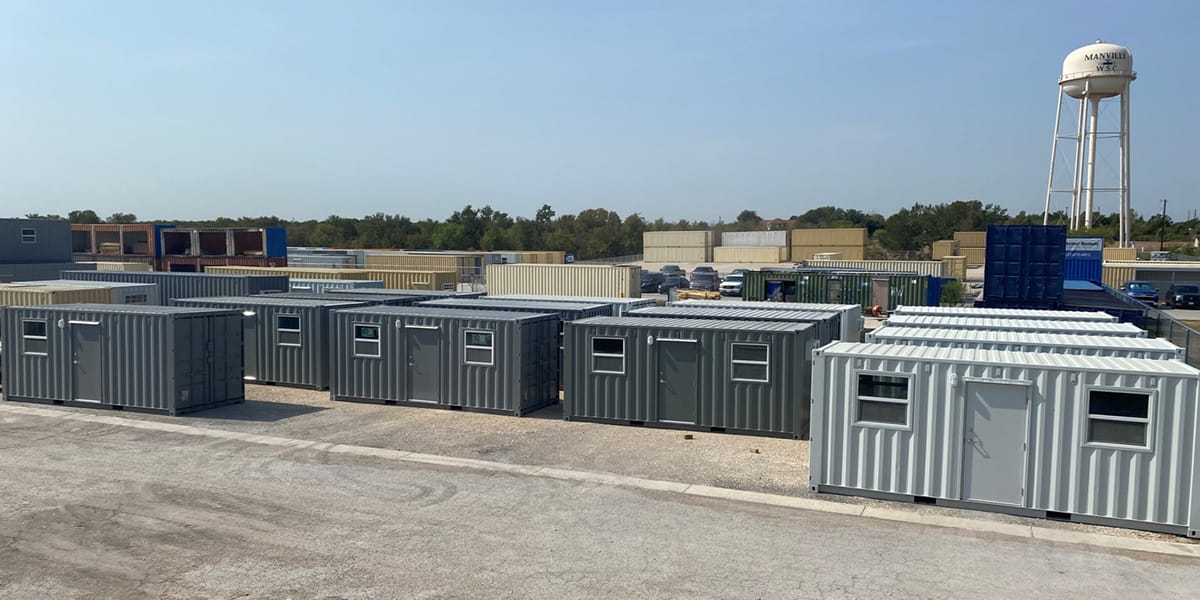The Field Office: How to Create a Better & Safer Construction Worker Experience

Becca Hubert is the Content Strategist at Falcon Structures.
More construction workers died on the job in 2022 than any other industry sector. The fatality rate has remained consistent for the last decade, with around 10 deaths per 100,000 workers, and construction deaths account for about 21% of all on-the-job deaths of workers in the United States. Consider the heavy machinery, steep heights, and dangerous materials workers in this industry face every day, and the risk factor makes sense. But just because there’s potential for injury and death doesn’t mean the industry should accept these numbers as the norm.
Organizations and associations around construction and occupational safety are calling for action to decrease these harrowing statistics. While training programs and educating workers on best practices are a natural step toward improvement, we’d like to consider another resource: the field office.
Here are a few ways a construction field office can help mitigate risk and promote a culture of safety.

Operations Center
A common complaint on construction sites is the lack of an office. In fact, many of our customers in the industry come to Falcon Structures for a portable container workspace because their foremen have resorted to working in their company vehicles. Aside from the convenience and comfort of a dedicated workspace, a field office can also serve as an operations center on construction sites.
- Give project safety personnel a workspace to conduct
- Control site access with a check-in point for guests or new workers.
- Use as an observation space to keep an eye on operations and safety practices.
- Securely store keys to heavy machinery and heavy-duty tools.
- Store devices like laptops and tablets for logging safety reports.
Safety Hub
Since construction sites relocate often, workers may not have a clear understanding of where to access safety gear and first aid kits from site to site. A portable field office can help enforce a standard of safety for construction crews, even as it relocates with the job.
- Store and distribute personal protection equipment (PPE), like harnesses, hard hats, and high visibility vests.
- Use as a center for safety messaging, like bulletin boards with notices and safety procedures.
- Conduct meetings for safety training and daily check-ins.
- Store first aid equipment in a standardized and easy-to-access location.

Relocatable field offices and support buildings are valuable assets on the job site.
Worker Respite
While 65.5% of construction deaths occur from the “fatal four” (falls, struck by object, electrocution, and caught in or between something), the toll on construction workers’ physical and mental well-being should not be ignored. In an industry that is notorious for its suicide rate and drug and alcohol abuse among workers, meeting the basic needs for comfort, bathrooms, and break areas can drastically improve worker well-being.
- Use a climate-controlled field office to cool off from working in dangerously hot weather.
- Modify a field office to include clean, climate-controlled restrooms so workers don’t have to walk too far to use facilities, brave rancid porta potties, or “hold it” for an unhealthy amount of time.
- Create a dedicated break area with air conditioning, kitchenettes, restrooms, and space for tables and chairs so workers can take proper breaks.
The statistics around construction worker safety and well-being are alarming, but there is a heartening culture of change on the horizon. Industry leaders and worker advocates are embracing new ways to shake up the bleak norms that have plagued construction for decades. A portable field office is a practical, versatile, and surprisingly powerful resource in the effort to save and improve the lives of construction workers.
More from Modular Advantage
AI, Faster Sets, and Automation: The Future of Modular is at World of Modular
While the modular building industry has long known that it can be an effective solution to increase affordable housing, the word is slowly spreading to more mainstream audiences. Three presentations at this year’s World of Modular in Las Vegas hope to provide insight and direction for those seeking a real solution to the crisis.
An Insider’s Guide to the 2025 World of Modular
The Modular Building Institute is bringing its global World of Modular (WOM) event back to Las Vegas, and with it comes some of the industry’s best opportunities for networking, business development, and education. Over the course of the conference’s four days, there will be numerous opportunities for attendees to connect, learn, and leverage event resources to get the most out of the conference.
Affordable Housing Now: The Industry’s Best Bring New Solutions to World of Modular
While the modular building industry has long known that it can be an effective solution to increase affordable housing, the word is slowly spreading to more mainstream audiences. Three presentations at this year’s World of Modular in Las Vegas hope to provide insight and direction for those seeking a real solution to the crisis.
Opportunities for Innovation in Modular Offsite Construction
Modular Offsite Construction has already shattered the myth that it only produces uninspired, box-like designs. Architectural innovations in module geometry, configurations, materials, and products make it possible to create visually stunning buildings without sacrificing functionality or efficiency.
Safe Modular Construction with Aerofilm Air Caster Transport
In collaboration with Aerofilm Systems, Heijmans developed innovative skids using air caster technology for moving modules easily and safely. These pallets are equipped with an auto-flow system, making operation extremely simple.
Miles, Modules, and Memes: Building a Modular Network One Flight at a Time
At the end of the day, social media is just another tool for building connections, and like any other tool, needs to be used skillfully to work properly. Use social media thoughtfully, and it will open doors to real opportunities and relationships you didn’t even see coming.
Falcon Structures: Thinking Inside the Box
Some of Falcon’s latest projects include creating container solutions for New York’s Central Park and an East Coast professional baseball team. More and more, Falcon is shipping out container bathrooms and locker rooms to improve traditionally difficult work environments, like those in oil and gas or construction.
UrbanBloc—From Passion to Industry Leader
UrbanBloc specializes in three main categories or markets – what they call “Phase 0” projects, amenities, and urban infill. Clients are often attracted to shipping containers because from a real estate perspective they are considered an asset. Having the flexibility to move and transport these assets allows owners to respond to different circumstances in a fluid manner that they can’t get with standard construction.
The Hospitality Game-Changer
“Hospitality is about more than just providing a service – it’s about delivering an experience,” says Anthony Halsch, CEO of ROXBOX. “And that’s where containers thrive. They allow us to create spaces that are unique, efficient, and sustainable.”
Container Conversions Counts on Simplicity to Provide Critical Solutions
Container Conversions has fabricated and developed thousands of containers for varied projects, including rental refrigeration options, offices, kitchens, temporary workplace housing, and mobile health clinics.










